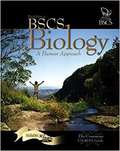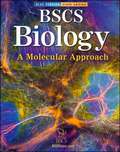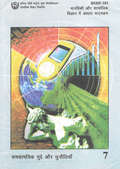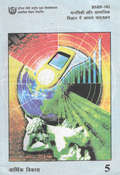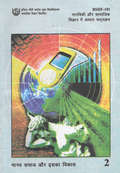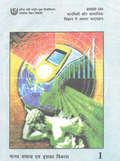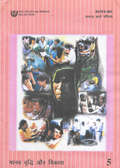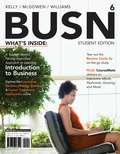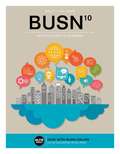- Table View
- List View
BSCS Biology: A Human Approach (2nd Edition)
by BscsThis book helps students learn biology through active involvement. With six key features of the program, viz., Unifying Themes, Subthemes, Instructional Model, Cooperative Learning, Assessment, and Educational Technology, students will enjoy learning biology in the new way of human approach.
BSCS Biology: A Human Approach (3rd Edition)
by BscsWhen faced with a problem or a puzzle, how do you figure things out? You might answer, "I think about them." But are you aware of how you think? This biology program focuses on science as one of the ways humans understand and explain their world. The activities throughout this program encourage you to think as a scientist does.
BSCS Biology: A Molecular Approach (Blue Version, Ninth Edition)
by The Editors at the BSCSThis book supports an inquiry approach to biology and challenges students to think scientifically, to integrate concepts, to analyse data, and to explore complex issues.
BSCS Biology: An Ecological Approach, Green Version (8th edition)
by BscsThis eighth edition of BSCS Biology: An Ecological Approach is the first edition of Green Version that will be used well into the twenty-first century, the beginning of a new millennium whose first decade will provide significant challenges to science education and to the quality of life on our ever-more-crowded planet.
BSCS Science: An Inquiry Approach
by Barbara Resch Fran SevinBSCS Science: An Inquiry Approach represents a new generation of textbooks for a new generation of high school science students, like you. As with all BSCS materials, An Inquiry Approach is an innovative science program that is centered on the Learner.
BSCS Science: An Inquiry Approach (Level 2-A)
by BscsBSCS Science: An Inquiry Approach represents a new generation of textbooks for a new generation of high school science students. This program is centered on you, the learner and introduces you to the core concepts in science as inquiry, the physical sciences, the life sciences, and the earth and space sciences.
BSCS Science: An Inquiry Approach, Level 3, Energy Forms and Flow
by Barbara ReschNIMAC-sourced textbook
BSHF - 101 Manvikee Aur Samajik Vigyan Me Aadhar Pathyakram - Khand 7 Samsamayik Mudde Aur Chunautiyaan - IGNOU: BSHF - 101 मानविकी और सामाजिक विज्ञान में आधार पाठ्यक्रम - खंड 7: समसामयिक मुद्दे और चुनौतियाँ - इग्नू
by Indira VishvavidyalayaBSHF-101 मानविकी और सामाजिक विज्ञान में आधार पाठ्यक्रम (खंड 7: समसामयिक मुद्दे और चुनौतियाँ) - इग्नू यह किताब इंदिरा गांधी राष्ट्रीय मुक्त विश्वविद्यालय ने हिंदी भाषा में प्रकाशित किया है । इस खंड की पाँच इकाइयाँ हैं, इन खण्ड में कुछ "समसामयिक मुद्दे और चुनौतियाँ" पर विचार किया गया है। खण्ड में मानव सुरक्षा, शिक्षा और जागरूकता, सूचना और संचार प्रौद्योगिकी, शान्ति और संघर्ष तथा पर्यावरण से सम्बद्ध समाज विज्ञान में उभरते हुए कुछ मुद्दों से परिचित किया है। इन इकाइयों में कुछ मुख्य प्रश्नों, चिन्ताओं, और वाद-विवादों पर चर्चा करने का प्रयास किया है।
BSHF -101 Manvikee Aur Samajik Vigyan Me Aadhar Pathyakram - Khand 6 Kalaen Aur Saundaryashastra - IGNOU: BSHF -101 मानविकी और सामाजिक विज्ञान में आधार पाठ्यक्रम - खंड 6: आर्थिक विकास - इग्नू
by Indira VishvavidyalayaBSHF-101 मानविकी और सामाजिक विज्ञान में आधार पाठ्यक्रम (खंड 6: कलाएँ और सौन्दर्यशास्त्र) - इग्नू यह किताब इंदिरा गांधी राष्ट्रीय मुक्त विश्वविद्यालय ने हिंदी भाषा में प्रकाशित किया है । कलाएँ और सौन्दर्यशास्त्र किसी भी समाज की सभ्यता सम्बन्धी प्रक्रिया के आधार हैं। उनमें हमें मानवीय कल्पनाशीलता और संवेदनशीलता की उच्चतम अभिव्यक्ति मिलती है। इस खंड में चार आधारभूत पहलुओं पर चर्चा की गई है अर्थात् (i) साहित्य, (ii) ललित कलाएँ, (iii) नृत्य व संगीत, और (iv) चलचित्र व रंगमंच। हमने इन इकाइयों में कला के उन विभिन्न रूपों की रूपरेखा प्रस्तुत करने का प्रयास किया है जो इन अभिव्यक्तियों में विकसित हुए हैं।
BSHF -101 Manvikee Aur Samajik Vigyan Mey Aadhar Pathyakram - Khand 2 Manav Samaj Aur Isaka Vikas - IGNOU: BSHF - 101 मानविकी और सामाजिक विज्ञान में आधार पाठ्यक्रम - खंड 2: मानव समाज और इसका विकास - इग्नू
by Indira VishvavidyalayaBSHF-101 मानविकी और सामाजिक विज्ञान में आधार पाठ्यक्रम (खंड 2: मानव समाज और इसका विकास) - इग्नू यह किताब इंदिरा गांधी राष्ट्रीय मुक्त विश्वविद्यालय ने हिंदी भाषा में प्रकाशित किया है । इस खंड में 4 इकाइयाँ हैं, जिनमें हम औनिवेशिक भारत के स्वरूप का अध्ययन करेंगे। विश्व के अन्य क्षेत्रों में होने वाले विकास की चर्चा करने के उपरान्त हम विशेष रूप से भारत पर ही ध्यान केन्द्रित करेंगे और हमको उन क्षेत्रों में औपनिवेशिक विस्तार के प्रभाव का अध्ययन कराएंगे जो औपनिवेशिक थी।
BSHF 101 Manvikee Aur Samajik Vigyan Me Aadhar Pathyakram (Khand 1 Manav Samaj Evan Isaka Vikas) IGNOU: BSHF 101 मानविकी और सामाजिक विज्ञान में आधार पाठ्यक्रम (खंड 1: मानव समाज एवं इसका विकास) इग्नू
by Indira VishvavidyalayaBSHF-101 मानविकी और सामाजिक विज्ञान में आधार पाठ्यक्रम (खंड 1: मानव समाज एवं इसका विकास) – इग्नू यह किताब इंदिरा गांधी राष्ट्रीय मुक्त विश्वविद्यालय ने हिंदी भाषा में प्रकाशित किया है । इस खंड में हमको समाज की संकल्पना से अवगत कराएंगे। समाज विज्ञानों में समाज तथा उसके अतीत, वर्तमान और भविष्य का अध्ययन किया गया है। मानव तथा आधुनिक समाज के उदय से संबंधित इकाइयाँ हैं। अंतिम इकाई में समकालीन समाज की धारणा विशेषतः उत्तर औधोगिक समाज की अवधारणा का परिचय दिया गया है। ये इकाइयाँ इस बात की जाँच करती हैं कि कैसे समाज में परिवर्तन घटित होता है और समय-समय पर उसमें परिवर्तन होता है समाज की इस परिवर्तन की प्रकृति के बारे में भी कुछ विचार व्यक्त किए गए हैं।
BSHF- 101 Manvikee Aur Samajik Vigyan Me Aadhar Pathyakram - Khand 4 Rajanitik Aur Prashasanik Pranali - IGNOU: BSHF -101 मानविकी और सामाजिक विज्ञान में आधार पाठ्यक्रम - खंड 4: राजनीतिक और प्रशासनिक प्रणाली -इग्नू
by Indira VishvavidyalayaBSHF-101 मानविकी और सामाजिक विज्ञान में आधार पाठ्यक्रम (खंड 4: राजनीतिक और प्रशासनिक प्रणाली) - इग्नू यह किताब इंदिरा गांधी राष्ट्रीय मुक्त विश्वविद्यालय ने हिंदी भाषा में प्रकाशित किया है । इस खंड में भारतीय राजनीति और सार्वजनिक प्रशासन व कार्यनीतियों की प्रकृति और संरचना के बारे में चर्चा की गई है। इस खंड में 4 इकाइयाँ हैं, जिनमें भारतीय संविधान की मुख्य विशेषताओं, भारत में लोकतंत्र की प्रकृति, प्रशासनिक संरचना और प्रक्रियाओं तथा शासन के मुद्दों व कार्यनीतियों का वर्णन किया गया है। इसका मुख्य उद्देश्य राजनीतिक और प्रशासनिक संस्थाओं की मूल कार्यप्रणाली की जाँच करना है।
BSWE- 001 Samaj Karya Parichay - Khand 5 Manav Vruddhi Aur Vikas - IGNOU: BSWE - 001 समाज कार्य परिचय - खंड 5 मानव वृद्धि और विकास -इग्नू
by Indira VishvavidyalayaBSWE-001 समाज कार्य परिचय (खंड 5: मानव वृद्धि और विकास) – इग्नू यह किताब इंदिरा गांधी राष्ट्रीय मुक्त विश्वविद्यालय ने हिंदी भाषा में प्रकाशित किया है । इस खंड में पाँच इकाइयाँ हैं, इसमें व्यक्तित्व विकास की अवधारणाओं और सिद्धान्तों का वर्णन किया गया है। पहली इकाई का विषय व्यक्तित्व विकास है, इसमें आपको व्यक्तित्व विकास की अवधारणाओं और सिद्धान्तों का परिचय दिया है। दूसरी इकाई "व्यक्तित्व निर्धारण : आनुवंशिकता और पर्यावरण की भूमिका" से संबंधित है। तीसरी इकाई "मानव विकास की विभिन्न अवस्थाएँ" में मृत्यु की सकल्पना से लेकर व्यक्ति की भौतिकीय मनोवैज्ञानिक परिवर्तनों की चर्चा की है। चौथी इकाई 'व्यक्तित्व के सिद्धांत" पर आधारित है। इसमें व्यक्तित्व के सिद्धांतों को स्पष्ट किया गया है जिसमें प्रख्यात मनोवैज्ञानिकों और अन्य विद्वानों के सिद्धांतों का अध्ययन किया है। पाँचवीं और अंतिम इकाई "मनोलैंगिक विकासः फ्रायड की अवधारणा" में व्यक्तित्व विकास की आपसी समझ के साथ फ्रायड के सहयोग का विश्लेषण किया है।
BUSN 6
by Chuck Williams Jim Mcgowen Marcella KellyCreated through a "student-tested, faculty-approved" review process with over 2,000 students and faculty, BUSN 6e is an engaging and accessible solution to accommodate the diverse lifestyles of today's learners at a value-based price. BUSN delivers all the topics found in lengthy Introduction to Business texts, but provides this content in a streamlined, riveting, less cluttered design that captivates students and saves you valuable time with powerful, integrated resources. CengageNOW is now being offered with BUSN 6e. Written by experienced business instructors in touch with the needs of today's instructors and students, this edition provides a more student-focused, less linear proven learning model. BUSN 6's lively engaging approach immediately draws students into business fundamentals with a compelling design that addresses all core Introduction to Business topics in only seventeen succinct chapters, including a unique chapter on Business Communication. Your students stay on top of the timeliest developments with the book's well-balanced presentation and wealth of supplements, including CourseMate, an interactive teaching and learning solution. All supplements are tightly integrated with the sixth fifth edition of BUSN to ensure your students master critical communication skills and chapter concepts. Keep all of your students motivated and excited about business today, no matter what their major, with the powerful, unique approach and resources found in BUSN 6.
BUSN10: Introduction to Business
by Chuck Williams Marce KellyThrough ongoing research into students' workflows and preferences, BUSN from 4LTR Press combines an easy-reference, paperback textbook with Chapter Review Cards, and an innovative online experience – all at an affordable price. With BUSN Online, students explore BUSN anywhere, anytime, and on most devices! The intuitive StudyBits™ functionality empowers students to study more effectively and visually monitor their own progress. Coupled with straightforward course management, assessment, and analytics for instructors, BUSN with BUSN Online engages students of all generations and learning styles, and integrates seamlessly into your Consumer Behavior Course. And with cutting-edge cases, engaging images, and profiles of today’s most compelling business visionaries, BUSN shows students how core business principles are applied at the world’s top companies every day.
Baby Animals (Fountas & Pinnell Classroom, Guided Reading Kindergarten)
by Peter GeorgeNIMAC-sourced textbook
Baby Badger (Adventures in Fosterland)
by Hannah ShawFrom New York Times bestselling author Hannah Shaw—also known as Kitten Lady—comes the third book in an exciting and heartwarming chapter book series following a small cat who&’s not sure what to make of new kitten arrivals! All is quiet in the city as beings big and small find shelter from a snowstorm, except for one tiny squeak. It&’s baby Badger, a newborn kitten with no momma to carry him to safety. He&’s cold and so alone—until a helpful human finds him and brings him to the warmest place on earth: Fosterland. There, baby Badger is still an orphan, but he has a cozy house filled with stuffed animal friends who become his family. With Miss Moose, Teddy, and Monsieur Crocodile by his side, Badger has everything he needs. Then, a cat named Mama Mia and her five kittens join him! And Badger isn&’t sure what to think of his new roommates. They do all sorts of confusing things: the kittens eat from their mom instead of from a bottle like him, and they lick each other. So odd! But as Leeni, Mia&’s sassy and bold kitten, begins to befriend Badger, he&’ll have a decision to make—stay in his cozy, safe space with his stuffed animals, or risk it all for a friendship with his potential new pals.

